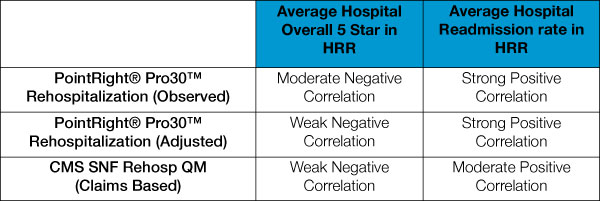
… Or, maybe you have more in common with the hospital than you think. Poor-performing hospitals tend to coexist in the same market as poor-performing skilled nursing facilities. Surprised?
How many times have you heard (or said) this statement?: “It’s the patients they’re sending me that set me up for failure.” While that might be true, it appears that the improvement opportunity exists on both sides of the fence.
Your initial reaction to the concept is likely outrage or understanding. Outrage at being referred to as a poor performer and/or understanding that referrals from a troubled hospital cannot be good news for a SNF. First, let’s define what we mean by “poor performing.”
In a recent study, we explored the relationship between a hospital’s Five-Star rating and readmission rate, to a SNF‘s Five-Star rating and rehospitalization rate. We grouped hospitals and SNFs into their respective 306 Hospital Referral Region (HRR) and looked at the average (mean) performance on these outcomes.
For those unfamiliar with the Hospital Five-Star rating system, it comprises 57 quality measures that relate back to seven domains: readmission, mortality, safety, timeliness, satisfaction, effectiveness and efficient use of medical imaging. You are probably most familiar with the hospital readmission measure, along with the SNF outcomes mentioned, but if not, please let me know and I’d welcome the chance to review them with you over a cup of coffee.
In the table below, correlations between the hospital and SNF outcomes are displayed. All findings are statistically significant. Correlations mean that a relationship between two sets of variables exists; correlations can be either positive or negative. Sometimes, we can use correlation to find causality (i.e. Did one thing actually contribute to another thing happening?), but not always.

Let’s discuss the negative correlations first, specifically the relationship between the hospital’s Five-Star rating and all three SNF rehospitalization measures. In this negative correlation scenario, as the hospital Five-Star decreases (worsens), then SNF rehospitalization rate increases, and vice versa.
Remember, the hospital’s Five-Star program is quite broad: 57 measures across seven domains of care. It might be that patients discharged from high-performing five-star hospitals have been well cared for, are satisfied with care and have well-conceived transition plans — the SNFs receiving their patients have lower rehospitalization rates.
Now flip the scenario: Low-rated hospitals sending you patients who are poorly cared for, dissatisfied and without properly conceived transition plans — those receiving SNFs have higher rehospilization rates. By definition, correlation does not prove these statements, but industry experience supports them.
The discussion becomes simpler when we consider the hospitals’ readmission rates having a strong positive correlation to PointRight® Pro30™ rehospitalization rates. When one goes up, so does the other, and vice versa. Both measures are more or less measuring the same outcome, and moving in the same direction.
The takeaway? I see two key things (and I’d love to hear what other thoughts you have over that cup of coffee). First, there is a common enemy and that is: “Return to Hospital.” Call it what you want — readmission (hospital) or rehospitalization (SNF) — chances are you and your hospitals are in the same boat. Well-performing hospitals (as measured by Five-Star) have lower readmission rates, which are correlated to lower SNF rehospitalization rates.
Second, if you don’t find that your experience aligns with these paradigms, that’s significant. If a hospital readmission rate is high, but your rehospitalization rate is low, chances are you’re outperforming your competitors in your HRR and have an impressive, data-rich story to share! If the opposite scenario is true, then it’s QAPI time.
Perhaps, before you enter or exit the preferred provider relationship, you can take a fresh look at the hospitals’ outcomes to anticipate your future experience and better define your competition.
And a final “parting shot”: SNF occupancy goes up when a hospital’s Five-Star goes down. Those poor-performing hospitals might just be keeping your beds full.
Next month, we’ll examine the relationship between the Hospital and SNF Five-Star ratings. Would you like to make a wager on the findings?
Steven Littlehale is a gerontological clinical nurse specialist, and executive vice president and chief clinical officer at PointRight Inc.





